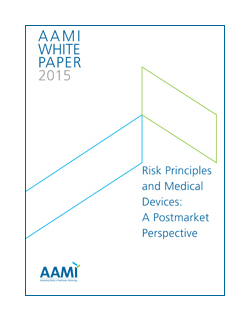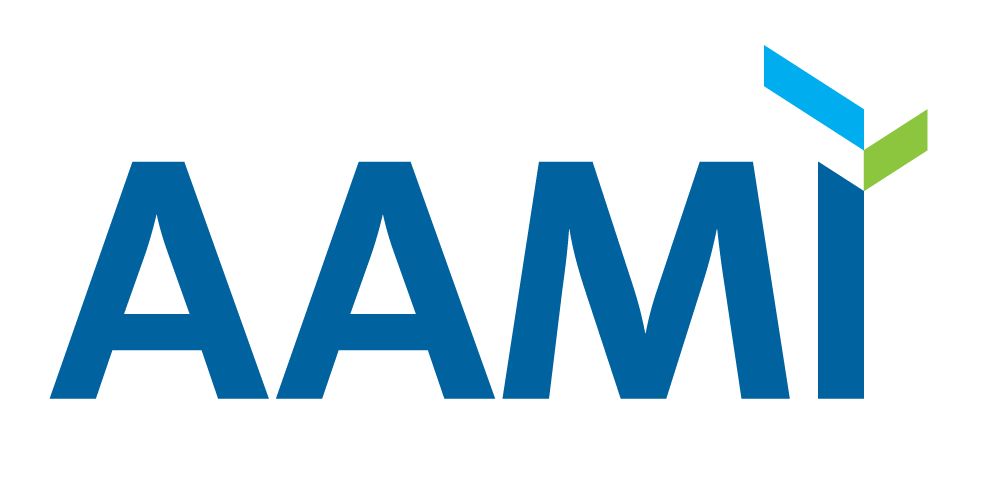AAMI White Paper Names Risk Principles for Medical Devices in Postmarket Setting
August 31, 2015
Contact: Gavin Stern: gstern@aami.org, 703-647-2781
A new white paper drafted by a special AAMI working group lays out six principles—developed jointly by industry and the U.S. Food and Drug Administration—to guide the management of risk of medical devices in the postmarket setting.
 The complimentary paper seeks to offer a “shared understanding” of risk principles, an important milestone in the ultimate goal of having better coordination and interaction between manufacturers and regulators when it comes to postmarket activities.
The complimentary paper seeks to offer a “shared understanding” of risk principles, an important milestone in the ultimate goal of having better coordination and interaction between manufacturers and regulators when it comes to postmarket activities.
“If industry and CDRH have a shared view based on a common risk management process, then less time should be lost resolving differences in understanding between CDRH and industry,” reads the paper, Risk Principles and Medical Devices: A Postmarket Perspective. “It is hoped that a shared view will minimize the differences in the assessment of risk and resulting conclusions reached by industry and CDRH related to appropriate remedial actions.”
The six risk principles are the following:
- Informed judgment in risk and benefit evaluations
- Loss-of-benefit assessment
- Populations
- Use environment and clinical assessment
- Communication
- Risk control and recovering loss of benefit
The paper covers specifics for each risk principle, and it includes a long list of factors to consider when applying those risk principles, such as complexity of use, software dependency, clinical impact on patients, and risks with alternative choices.
Beyond its clear delineation of six risk principles, the white paper succeeded on a broader level, simply by fostering and supporting an open discussion between medical device manufacturers and CDRH staff. Additionally, those involved in the white paper believe it can be instrumental in guiding the future work of a standards committee, ISO Technical Committee 210, that maintains a crucial risk management standard for medical devices, 14971.
Significantly, AAMI and the working group see the white paper as “a starting point” in developing a more productive and efficient approach to risk management in the postmarket setting.
“The next steps will be even more important, as subgroups begin to tackle harder questions around the application of the risk principles in various compliance scenarios where industry and FDA in recent years have not been aligned with a shared view of risk,” the paper states. Attendees of the upcoming AAMI/FDA Risk Management Summit on Sept. 29-30 will be updated on this second phase of the initiative, which is underway.
AAMI President Mary Logan noted that the working group will need to develop a plan this fall and winter for how these principles will be used to build on the progress that is being made. “Agreeing on what’s in this white paper is a beginning step in a much longer and harder shift in culture, thinking, and the application of risk principles to real-life situations when FDA and industry are in discussions about postmarket risk issues that arise.”
The paper reflects a collaborative effort of a CDRH/industry working group that was convened by AAMI in the fall of 2014, at the request of CDRH. That working group was comprised of members named by AAMI, three national industry trade associations—AdvadMed, the Medical Imaging & Technology Alliance (MITA), and the Medical Device Manufacturers Association (MDMA)—and the FDA. An initial draft of the white paper was released for public comment this past February. Close to 300 comments were submitted and considered in the final revision.
The complete white paper, which includes a list of the working group members, can be downloaded here.
AAMI (www.aami.org) is a nonprofit organization founded in 1967. It is a diverse community of more than 10,000 healthcare technology professionals united by one important mission—supporting the healthcare community in the development, management, and use of safe and effective health technology. AAMI is the primary source of consensus standards, both national and international, for the medical device industry, as well as practical information, support, and guidance for health technology and sterilization professionals.
